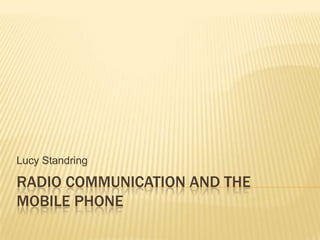
Radio communication and the mobile phone
- 1. Radio communication and the mobile phone Lucy Standring
- 2. RADIO Communication Radio as a form of communication has been apparent for over 100 years. Guglielmo Marconi made the first radio transmission in 1895. Within 30 years of this first transmission radio was being used in everyday life for broadcasting as well as communication within the police and military.
- 3. How radio communication works The frequency wave used for radio communication is called a carrier wave. These waves are produced and transmitted from the transmitter as a sine wave. A sine wave is only able to convey minimal information, but can be switched on and off, which was used within the Morse code process. If more information is needed, modulation needs to occur (see the next slide for more information). Within modulation some aspect of the carrier wave much be varied, for example for FM it is the frequency.
- 4. Amplitude modulation This is the process of attaching information to a carrier wave ready for transmission. Amplitude modulation is carried out to allow more data to be transmitted. Within the process the amplitude of the carrier wave is varied. This is done within accordance of the information being transmitted (for example speech and music tracks).
- 5. Electromagnetic waves Electromagnetic waves are received and emitted by mobile phones and their base stations. They can be emitted by natural sources (such as the warmth from the sun), as well as man-made sources (such as mobile phones). They are made up of oscillating (vibrating rapidly) electric as well as magnetic fields. The frequency of these fields determines their properties and use. We also see using part of the electronic spectrum, which the eye detects as visible light.
- 6. Mobile phone networks Mobile phones send and receive data (text messages, voice messages etc.) via radio communication. Radio frequency signals containing the data are firstly sent from the phone to the nearest base station. These signals are then transmitted to the main telephone network, by either: - telephone cables - higher frequency radio links between an antenna at base station and another at a terminal connected to the main telephone network
- 7. Base stations Every base station provides radio coverage a specific area. Connected to one another by central switching centres. These central switching centres track calls and transfer them to different base stations as the callers moves around. Base stations cells overlap, to ensure mobile phone users are always within range of one. Size of the cell for a base station depends on: - Local terrain – Signals can be blocked by trees, buildings etc. - Frequency band the network operates in. - Capacity needed in the given area. Typically spaced between 0.2-0.5km apart in towns and 2-5km apart in the countryside.
- 8. Key words Electromagnetic waves – AKA radio waves, contain both electric and magnetic fields, can be emitted and received. Frequency – The number of wave oscillations per second, measured in Hz (hertz). Carrier wave – A radio wave that can be modulated in order to transmit information. Sine wave – Waveform which looks like a sine curve Modulation – Varying an aspect of a carrier wave, for example amplitude, frequency etc.
- 9. References PUBLIC TELECOMMUNICATION NETWORKS UNIT (2001) How Mobile Phone Networks Work [WWW] Ofcom. Available from: http://www.sitefinder.ofcom.org.uk/mobilework.htm [Accessed 26/01/11] PANDA (n.a.) Marconi Guglielmo[Online image]. Available from: http://panda.unm.edu/Courses/Finley/pix/MarconiGuglielmo.jpg [Accessed: 26/01/11]. WIKIMEDIA (n.a.) Amplitude modulation [Online image]. Available from: http://upload.wikimedia.org/wikipedia/commons/thumb/d/df/Amplitude_modulation.svg/585px-Amplitude_modulation.svg.png [Accessed: 26/01/11]. TODAYIFOUNDOUT (n.a.) Electromagnetic spectrum [Online image]. Available from: http://www.todayifoundout.com/wp-content/uploads/2010/08/114284main_EM_Spectrum500.jpg [Accessed: 26/01/11].